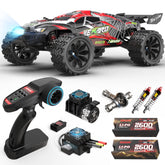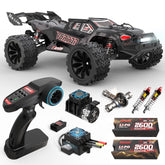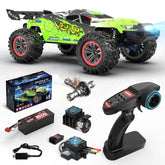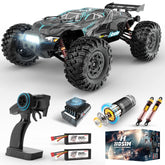Choosing the Best Li-Po Battery for Your RC
A fully charged battery is an essential part of any RC adventure! Whether you’re bashing in the backyard or heading out for a day on the trails, it’s important to have the right battery for the job. In this short article, we’ll be taking a look at Lipo (lithium polymer) batteries, the different factors you’ll want to consider when selecting one, and the issues that may arise from choosing the wrong one. Whether you just want to learn more about batteries in general or are actively hunting for more batteries, you’re sure to find something of use below!
Choosing a Connector
There are many different types of connectors used for Lipo batteries. However, not every connector is created equally! Some connectors are capable of handling higher amperage, while others are best left for low-amp purposes (such as lighting). The exact maximum amperage rating (the point of complete failure) may vary slightly from the list below, but this should give you a relative idea of which connector is suitable for your RC. Here are a few of the most common battery connector types!
|
Battery Connector Type |
Max Continuous Current Rating |
|
JST |
5 Amps |
|
Tamiya |
5 Amps |
|
Deans |
60 Amps |
|
XT60 |
60 Amps |
|
XT90 |
90 Amps |
|
EC3/IC3 |
60 Amps |
|
EC5/IC5 |
120 Amps |
It’s important that your choice of battery has the same plug type as your ESC if you want the best performance possible. While there are many adapters available online, you want to avoid using these if possible! Using an adapter will actually reduce the performance potential of your battery; worst-case scenario, the adapter could melt from too high of an amperage!
We recommend choosing one (or two) connector styles for all of your RC vehicles. While some connectors may need to be replaced with a soldering kit, this will prevent you from needing to charge specific batteries for specific vehicles.
Considering the Physical Size
It would be nice if a 6,000mAh hard case Lipo could fit into any RC car. After all, who doesn’t want a longer runtime!? Unfortunately, the size of your RC’s battery compartment is usually a hard limit when it comes to battery choices. If you need a replacement battery, it can be tempting to buy aftermarket batteries. They’re often better than the manufacturer’s provided batteries, but that doesn’t mean they’ll always fit!
There’s nothing worse than ordering a replacement battery that doesn’t fit, so measuring the battery compartment is something you should always do before purchasing replacement (or additional) batteries that aren’t manufactured specifically for your vehicle. Fortunately, most battery listings will provide you with the appropriate dimensions needed (length by width by height).
|
|
Hardcase Vs.Softcase Batteries You can buy either hardcase or softcase batteries. Hardcase batteries keep the battery cells protected by a plastic casing, but this casing means less capacity (mAh) in relation to the size of the battery. Softcase batteries provide the maximum capacity (mAh) in relation to the size of the battery since the cells aren’t surrounded by a bulky casing. The downside of this is that the battery is more prone to damage since it lacks any protection. |
Comparing Capacity
Lipo batteries are measured in “mAh”, or milliampere hours. The higher the mAh of a battery, the longer you’ll be able to use it before it dies! However, it’s important to remember that the amperage rate consumed while running will vary from RC to RC. As such, a 2,600mAh battery may not last as long on “Vehicle A” as it does on “Vehicle B”.
Knowing the capacity of your battery is especially helpful if you’re using a hobby-grade charger. While some batteries can be safely fast charged, any Lipo battery can be charged at “1C” (Li-on batteries should be charged at 0.8C”). Here’s an example:
5,200mAH Lipo Battery
|
Capacity |
x 1C |
= Amp Charging Rate |
|
5,200 |
x 0.001 |
5.2A |
5,200mAH Li-on Battery
|
Capacity |
x 0.8C |
= Amp Charging Rate |
|
5,200 |
x 0.0008 |
4.16A |
What is a ”C” Rating?
The “C” rating of a battery lets you know how fast it can be safely discharged (or charged!). Most batteries will only have the discharge “C” rating on them (if available, the charging “C” rating will be labeled separately). The higher the C rating, the higher the current (amperage) the battery is able to provide! These things can be hard to conceptualize so let’s look at another example.
Let’s say you have two 1,000mAh batteries, one with a “C” rating of 25C and another with a “C” rating of 100C. First things first: we need to calculate the available amps! In this case, it’s simple since 1,000mAH equals 1A.
Next, we take the available amps (1A) and multiply that by the “C” rating. This will give us the maximum amperage output of the battery!
- For the 25C battery: 1(A) x 25(C) = 25 amps (the maximum theoretical output)
- For the 100C battery: 1(A) x 100(C) = 100 amps (the maximum theoretical output)
Here are the steps simplified:
- Calculate the amperage by dividing the mAh of your battery by 1,000.
- Multiple the amperage of your battery by the “C” rating of the battery.
- Hate math? Click hereto use a calculator instead!
|
This “480A” ESC is really a 60A ESC. The “480A” claim is actually the peak current! |
While using a battery with a maximum amperage that exceeds the amperage of your ESC shouldn’t burn out your ESC, that doesn’t mean it can’t indirectly. The issue comes from the additional heat that can be generated from a higher “C” battery! For example, if your “60A” ESC was already getting hot at 45A (the maximum output of your first battery), replacing the battery with a 100A battery could overheat your ESC further, resulting in damage and eventual failure. The battery itself doesn’t push current though: the ESC draws the current in! As such, even though the new battery could output 100A, the ESC could only draw a continuous 60A. However, if overheating was already a problem at 45A then it will surely become an issue at 60A! Once you consider the fact that the “peak” current of a “60A” ESC is often much higher than the 60A continuous rating, it starts to make sense how using a higher “C” rating battery can overheat—and eventually destroy—an ESC.
|
Selecting the Right Voltage
The ESC of your vehicle will usually tell you which type(s) of battery it’s rated for. The higher the voltage, the faster the motor will spin! However, each electronics system has its limitations, and overvolting the system will cause more wear & tear. You’ll want to ensure that your battery falls under the maximum voltage limitations of both your ESC & the motor you’re using!
1S, 2S, 3S, 4S, 6S, and 8S are the most common battery types, although 5S & 7S batteries do exist.
Although the easiest way to achieve a 4S current is by using a 4S battery, it’s also possible to achieve a 4S current using two 2S batteries. This is known as running your batteries in series! When two batteries are run in series, the final voltage is the sum of both batteries. Conversely, running two batteries in parallel increases the overall mAh, but it won’t increase the voltage.
|
Battery Type |
Nominal Voltage |
Max Voltage |
|
1S |
3.7v |
4.2v |
|
2S |
7.4v |
8.4v |
|
3S |
11.1v |
12.6v |
|
4S |
14.8v |
16.8 |
|
5S |
18.5v |
21v |
|
6S |
22.2v |
25.2v |
|
7S |
25.9v |
29.4v |
|
8S |
29.6v |
33.6v |
Common Battery Issues You May Run Into
- Reversed Polarity- While most connectors will match positive to positive and negative to negative, it’s always a good idea to ensure that the polarities match before plugging a new battery in. Otherwise, you may cause irreversible damage to your battery, cables, and electronics!
- A Battery That Won’t Charge - If your battery won’t charge, the first thing you should do is to test the voltage. When the voltage of a cell is too low (below 3.0V), your charger may refuse to charge it. However, if the voltage isn’t low then you should try another charger. If you’ve confirmed that the connections are good but another charger doesn’t work, it’s time to replace your battery!
- Explosions & Fires- By nature, Lipos are volatile batteries. While the likelihood of them randomly exploding isn’t particularly high, it’s much more likely than with other types of batteries (such as Li-on batteries). You should always store and charge your Lipo batteries in a Lipo-Safe Bag and store them on a non-flammable surface. Not convinced yet? Here’s a good example of why Lipo safety is important!
- Imbalanced Cells- When charging Lipos, you should always balance charge them to ensure each cell has an equal voltage. However, you might notice a difference between the voltage in each cell after you’ve drained the battery. A minor difference is normal, but a large difference is problematic. If this disparity continues—or worsens—then it may be time to replace your battery!
- Extended Charging Times- As mentioned above, most batteries can be safely charged at 1C. However, the charger that’s included with your RC may not be capable of charging your batteries at 1C! We recommend grabbing yourself a hobby-grade charger to charge your batteries faster.
By Kevin Foley






















































































































Leave a comment
Please note, comments need to be approved before they are published.